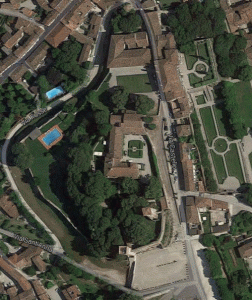Castle Volta Mantovana
Castle Volta Mantovana dates from the eighteenth-nineteenth century and later became part of the series of fortifications of the northern territories of the family Canossa;
it is in fact mentioned in a deed of donation of the same to the bishop of Mantua by Beatrice Canossa in 1055. From other documents of the time, we learn that the fortification consisted of two parts, one inside and one outside the castle keep and oval , composed by a wall of pebbles and bricks about five meters high, this opened some gates and was surrounded by a moat. The castle Volta Mantovana, from the eleventh to the fourteenth century was an important link in the chain of fortifications of the territories of ‘high Mantua and, given the frequent conflicts with neighboring the Scala family, was added by the Gonzaga a second outer walls to protect even the village and the Romanesque church, it also served as a shelter for the grain grown in the area, as proof of this, in 1468 the vicar asked permission to the Marquis Gonzaga to distribute to the people of Cavriana Goito and a part of the same. During the fifteenth century the Gonzaga will make building inside the fort a summer residence, what is now Palace Gonzaga – Cavriani, built close to the keep reusing part of murra boundary. In later centuries the fort was damaged either during the passage of the troops of Emperor Ferdinand II and during the independence wars of the nineteenth century. The fortifications and the castle Volta Mantovana to date remain well preserved parts of the city to the south and west of the village, other parts incorporated in homes east, while to the north the original boundary wall and a tower have been incorporated in Palace Gonzaga – Cavriani.

